| Knowledge Center
Note: Full versions of the following
materials are available for a limited time only. In 2015-16, abstracts of Knowledge Center materials will be
publicly available and complete versions of many ACCO reports,
case studies, etc. will be made available to ACCO members only.
The Time is Now – Doubling
Down on Climate Leadership:
Part 1 (Breathe)
People who work on climate change policy and action planning
across sectors are terrified – and they should be. The election
of a President and Congressional leadership that have announced
their intent to turn the past 8 years of Federal agency and
international climate action upside down should be scary. But it
also should be a rallying call. The time is now – we simply
cannot wait even a minute longer. The world is moving forward on
climate change with or without the United States. Global
companies will have to deal with international and foreign
policy efforts aimed at curbing emissions and preparing impacted
and vulnerable communities. Local and provincial governments are
acting already given the localized impacts and implications. To
be clear, giving up is NOT an option. So, let’s take a deep
breath and reorganize our thoughts.
Integrating Renewable
Energy into the Energy Portfolio at Lockheed Martin
Since September 2014, Samantha Baker has been serving as an ACCO
Future CCOs fellow at Lockheed Martin Corporation (Lockheed
Martin) examining the business case for renewable energy
procurement at both the corporate and individual site level. Her
work has focused on the development of a corporate level
renewable energy procurement approach that aligns with Lockheed
Martin’s overarching energy procurement program. This has
included analysis of opportunities to reduce short and long-term
costs, minimize exposure to fuel or electricity price risks, and
align with Federal customer renewable energy requirements. The
report is intended to share the process that was undertaken, as
well as some of the outcomes of that work, with content based
upon Samantha's research, experience and observations, as well
as published historical accounts.
6 Easy Steps to Turbo Boost
Climate Action in Local Government
While nations deliberate on national and international policy
related to climate change, local governments worldwide are faced
with the daunting challenge of addressing the localized
implications of climate change on their communities and
operations. Ultimately, climate change poses an unparalleled
volume and diversity of challenges for any organization, much
less local governments who frequently do not (or may not think
they) have sufficient resources to successfully address these
considerations.
Let’s think about this as a maturity model. First you come to
accept that you have a problem. Once you’ve done so, a public
administrator or elected leader will task someone to be
responsible for addressing the issue. In this case, an
environmental professional, sustainability director or
resilience officer may have been hired or designated from
existing staff. This is a great start, but even in the best of
circumstances, a few people here and there trying to address the
scope of implications facing that community is truly
insufficient. I would compare this to mice trying to move a
battleship.
The Paris Climate Change
Agreement – Business Must Adapt or Die
December 12, 2015 – the date that 196 nations reached a global
agreement in Paris on climate change – may well be remembered as
the critical turning point in mankind’s battle to slow down and
minimize the impacts of global warming. Under the Paris
Agreement, each signatory nation pledged to reduce greenhouse
gas ("GHG") emissions beginning in 2020, under a self-imposed
goal known as an "individual nationally determined contribution"
("INDC"). Each signatory nation must publish an emissions
inventory, as well as information necessary to track the
nation’s progress in achieving the INDC.
The Paris Agreement has detractors from
across the political spectrum. For example, island nations
threatened by rising sea levels say that the Paris Agreement’s
goal of limiting global warming to 2° Celsius (3.6° Fahrenheit)
is insufficient to protect them from submerging. Climate change
activists contend that under the deal’s timetables the
transition away from fossil fuels is too slow, leaving open the
possibility of irreversible catastrophic damage to the climate.
Professor James Hansen, the former NASA scientist sometimes
called the father of climate change, bluntly stated: "It’s a
fraud really, a fake... there’s no action, just promises."
Key Considerations For
Renewable Energy Contracting
Purchasing utility-scale renewable energy can be a very
complicated business. While deciding on the right project type
and site are certainly critical pieces of the puzzle,
negotiating with developers, navigating the contracting process,
and coordinating all parties involved are just as important, and
projects often sink or swim based on how these are handled. ACCO
spoke with Rick Coulon (Interim Associate Vice Chancellor,
Administrative & Business Services at University of California,
Irvine) who shared some great information on the intricacies
of contracting for PPAs at a large academic organization,
including process, negotiation, timeframes, guarantees and
assurances, and potential stumbling blocks.
Navigating the Challenges
of Renewable Energy Purchasing and PPAs
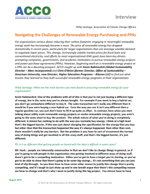 |
|
For organizations serious about reducing their carbon footprint,
engaging in meaningful renewable energy work has increasingly
become a must. The price of renewable energy has dropped
dramatically in recent years, particularly for larger
organizations that can leverage sizeable demand to negotiate
lower prices. This change, increasingly volatile market prices
for fossil fuels and conventional electricity, and efforts to
meet organizational GHG goals have been key drivers prompting
companies, governments, and academic institutions to pursue
renewable energy projects and power purchase agreements (PPAs).
However, beginning work on a renewable energy project or a PPA
can be a daunting prospect. ACCO caught up with Kevin
Rabinovitch (Global Sustainability Director – Mars Incorporated)
and Chris O’Brien (former Director, Office of Sustainability
– American University, now Director, Higher Education
Programs – Altenex LLC) to find out what lessons they learned as
they built successful renewable energy programs at their
organizations.
Advancing Climate
Protection Strategies at The Coca-Cola Company
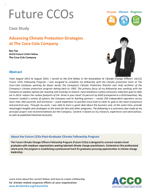 |
|
From 2013-2014, Ran Tao served as the first fellow in the
Association of Climate Change Officers' (ACCO) Future CCOs
Fellowship Program. He was assigned to complete a year-long
fellowship with the climate protection team at The Coca-Cola
Company working for Bryan Jacob, the Company’s Climate
Protection Director and chief architect of the Company’s climate
protection program dating back to 1993. The primary focus of
this fellowship was working with the Company to explore options
for meeting and tracking its newest, most ambitious carbon
emissions reduction goal to date set in 2013: reduce the carbon
footprint of the 'drink in your hand' 25 percent by 2020
(compared to a 2010 baseline). His research studied a variety of
options the Company and its bottling partners – nearly 250
independent operators across more than 200 countries and
territories – could implement to position Coca-Cola to meet its
goal in the most economical and practical way. Through his work,
he was able to learn a great deal about the business and, at the
same time, provide meaningful insights and strategies to the
team for this and other programs. The following is a summary
case study of the principal project and recommendations for the
Company. Content is based on Ran's research, experience and
observations, as well as published historical accounts.
Transforming Higher
Education Institutions to Serve as Laboratories for Informing
Decision Making on Climate Risk
Climate change presents a cascading and increasingly dramatic
set of impacts that will require an all-hands-on-deck approach
to re-conceiving how communities are designed, businesses
operate and individuals consume natural resources. In the
workplace, organizations will be challenged to anticipate and
proactively address the implications of a changing environment
upon their operations.
As climate change impacts accelerate, our current systems of
governance, management, education and training will be
overwhelmed with challenges unless we rapidly deploy a workforce
in large scale to redesign all of the systems and structures
that are foundational to developed nations.
Sea Level Rise Adaptation
in the Public Sector: Challenges, Solutions, and Opportunities
 |
|
As climate change progresses, the relentless march of sea level
rise (SLR) presents an array of challenges and opportunities to
coastal cities and towns in the United States and worldwide.
Along the northeast coast of the U.S. in particular, sea level
is projected to rise at rates three to four times faster than
the global average due to local variations in ocean circulation,
salinity, and temperature. If the U.S. continues with business
as usual, between $238‐507 billion worth of existing coastal
property nationwide is likely to be below sea level by 2100.ii
This figure does not include flooding of roads and other
critical infrastructure or related costs to the millions of
people who will be displaced or impacted. Continued information
sharing and collaborative efforts among American cities is vital
in the effort to safely and efficiently navigate the challenge
and capitalize on the opportunities presented by SLR.
Some cities and public entities in the U.S. have begun serious
work on coastal adaptation planning, and are ahead of the curve
in terms of preparing for the impacts of SLR on infrastructure
and property. Adaptation planning in municipalities is important
for protecting property and public health as well as the
businesses that sustain community economies. A recent report
from CDP found that actions by city governments to address
climate impacts such as SLR also serve to make businesses more
resilient to climate risk.iii Municipalities that direct
attention to adaptation planning are better able to sustain
existing economic drivers and may also attract business from
other areas that do not strive to become more resilient.
Rising Above the Seas:
SECing Materiality Through the Corporate Lens
Business continuity is a familiar concept to corporations that
has traditionally encompassed planning and preparation for
disruptive incidents and disasters (e.g. fires, earthquakes,
floods, etc.) to ensure businesses are protected and/or will
recover to an operational state within a reasonable period of
time. It’s becoming more and more difficult to ignore climate
risks due to the increased frequency of extreme weather events
such as hurricanes, droughts, and the focus on this paper, sea
level rise. It is sensible, therefore, to include climate risks
in such planning and preparations.
The obvious examples of recent climate risks are the costly
Hurricanes of the Gulf Coast – specifically, Katrina of 2005 –
the historic Thailand floods of 2011 and Typhoon Haiyan of 2013,
and Superstorm Sandy in the Northeast United States in 2012, all
of which were intensified due to sea level rise. While these
events were far from ideal occurrences, they may have served as
instrumental enablers in many cases for building the business
case for companies to redesign resiliency strategies and/or
build such strategies from the ground up as new business
operations are constructed.
Tomorrow’s Luminaires: San
Diego’s Vision for Turning Streetlights from Cost Centers to
Efficient Smart Infrastructure
Outdoor lighting is a necessary investment for any municipality,
academic institution, or large private company with a
substantial physical footprint. The light that pedestrian and
parking luminaires provide is essential for nighttime operations
and safety, and accounts for significant cost in terms of
physical infrastructure and energy use as well as maintenance
and service. Worldwide, lighting is responsible for 19 percent
of all electricity use, and for the average city, streetlights
account for around one quarter of total electricity use and are
often the largest single line item on the energy bill.
The City of San Diego is a national leader on climate change, as
evidenced in its ambitious Climate Action Plan. The government
is undertaking a wide range of efficiency and renewable energy
work in order to meet state GHG reduction targets of 15 percent
below business as usual (BAU) by 2020 and 49 percent below BAU
by 2035, even as the City’s population continues to grow. San
Diego has developed its Smart City Infrastructure project to
work toward climate change mitigation while also reaping the
economic benefits of energy and operational efficiency, system
control, and other possibilities for future wireless
functionalities and services.
Effective
Supplier Engagement — How Sprint is Greening its Supply Chain
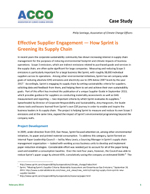 |
|
In recent years the corporate sustainability community has shown
increasing interest in supply chain management for the purposes
of reducing environmental footprint and climate impacts of
business operations. Scope 3 emissions, which are indirect
emissions related to purchased goods and services in the supply
chain, are often quite significant for large companies.
Measuring and reducing Scope 3 emissions is particularly
important for a large business like Sprint, with roughly 38,000
individual suppliers across its operations. Among other
environmental initiatives, Sprint has set company-wide goals of
reducing absolute GHG emissions and electricity use to 20% below
2007 levels by the year 2017. Accordingly, Sprint is engaging
its supply chain by setting sustainability criteria for
suppliers, soliciting data and feedback from them, and helping
them to set and achieve their own sustainability goals. Part of
this effort has involved the publication of a unique Supplier
Guide in September 2013, which provides guidance for suppliers
on conducting materiality assessments as well as GHG measurement
and reporting — two important criteria by which Sprint evaluates
its suppliers. Spearheaded by Director of Corporate
Responsibility and Sustainability, Amy Hargroves, the Guide
shares tools and lessons learned from Sprint’s own CSR journey
in order to enable and inspire the business leaders in its
supply chain. The project is helping Sprint to measure and
reduce its own Scope 3 emissions and at the same time, expand
the impact of Sprint’s environmental programming beyond the
company walls.
District of Change — The Department
of General Services Transforms DC into a Climate Powerhouse
Mayor Vincent C. Gray created the DC Department of General
Services (DGS) in October of 2011. The result of the
consolidation of several former agencies, including those
managing municipally-owned office buildings and DC Public
Schools, DGS is tasked with increasing efficiency and
effectiveness within the District’s 400+ building (totaling
nearly 30M sqft) portfolio of real estate. Sam Brooks joined DGS
in February 2012 as Associate Director, and head of its Energy &
Sustainability Division, around the time Mayor Gray developed
his Vision for a Sustainable DC. The plan included several
ambitious climate-related goals for the District: a 50%
reduction in GHG emissions, a 50% reduction in citywide energy
consumption, and an increase of renewable energy use to 50%.
During the next two years, Brooks helped
the District work toward these goals through a variety of high
impact projects to increase energy efficiency and renewable
power supply, including smart metering and efficiency data
analysis, negotiation of utility-scale wind and solar power
purchases agreements (PPAs), and purchase of RECs to cover 100%
of city power use. The Association of Climate Change Officers (ACCO)
spoke with Brooks about the Department’s current and future work
on energy and climate change mitigation, and gained valuable
insight for energy management and climate officers working in
both the public and private sectors.
Business Drivers Impacting
Establishment and Implementation of Greenhouse Gas Emissions
Reduction Goals
(complimentary abstract
report; comprehensive report can be purchased in
ACCO online
store)
|
|
Abstract Report |
|
Complete Report |
|
|
 |
|
 |
As organizations address climate change risks and
opportunities many have turned to greenhouse gas (GHG)
emissions management as a tool for understanding and
addressing aspects of the issue as they pertain to
their operations. Many organizations have publicly
committed to reducing their GHG emissions by
leveraging strategies incorporating energy
efficiency, renewable energy, employee engagement
and behavior change, and process improvement; such
goals are now widely used in a variety of
corporations, universities, and government entities.
Although GHG emissions reduction goals are being
undertaken by many organizations, it is not
immediately clear what drives the efforts in the
absence of a regulatory or executive mandate. In
order to learn more about drivers and challenges
affecting these activities, ACCO issued a survey to
a group of climate professionals across sectors in
Spring 2013 to identify the factors that were
driving organizations to pursue GHG emissions
reduction goals.
The report provides findings
and trends related to drivers affecting
organizations based on the nature of their reduction
goals, role of the GHG managers within the
organization, sector of the organization and
challenges they are facing.
Challenges and
Opportunities in Supply Chain Environmental Sustainability
Disclosure
(available in
abstract and complete formats)
|
|
Abstract Report |
|
Complete Report |
|
|
 |
|
 |
Environmental sustainability has become an
increasingly important topic for organizations of
all types in recent years. There has been a push not
only to evaluate the sustainability performance
within an organization’s own operations, but also to
evaluate the impacts of the organization’s supply
chain. This push has resulted in a proliferation of
sustainability supply chain surveys and
organizations have had to dedicate an
increasing amount of time to respond to them.
Over the past two years, ACCO
has hosted exploratory conversations designed to
examine the prospects of harmonizing supply chain
questionnaires. Based on those discussions, ACCO
established an advisory group consisting of leading
NGOs and multinational corporations to oversee a
research project conducted by graduate students in
the Nicholas School for Environment at Duke
University. In 2012-2013, the Duke project team
interviewed dozens of supply chain leaders on the
topic and analyzed supply chain questionnaires from
leading companies, trade groups and NGOs.
The resulting report provides
an in depth analysis of existing activities taking
place and makes recommendations for harmonizing
supply chain questionnaires. This report will
serve as the foundation for a large
multi-stakeholder effort that ACCO will convene to
move forward with this effort.
Climate Adaptation:
A Survey of Concerns Facing Organizations
As organizations and entities across sectors implement climate
adaptation plans and policies, leaders are increasingly in need
of high‐quality information to make better decisions. To find
this information, it is common practice for managers to look to
their peers for lessons learned and best practices. This
approach works well for seasoned constituencies who share
time‐tested experiences, which are often standardized and
accredited. However, though rapidly rising in popularity,
managing the impacts of climate change is still in its infancy.
Field tested lessons have yet to crystallize and best practices
have a long way to go before they are standardized.
To help resolve this issue, we took a
hard look at the process of planning for climate impacts across
sectors. We discovered emerging trends in climate adaptation in
different sectors as well as obstacles identified by
practitioners. These obstacles, which we refer to as “barriers,”
range from the simple to the complex. For example, some managers
lack the time to research the latest climate change science.
Some managers reported that, despite being tasked with managing
impacts from climate change, they do not have financial support
from their respective organizations. In still other cases,
decision makers with clear mandates and well developed plans
struggle with training their staff and have a difficult time
communicating goals with various stakeholders.
Note: This report is an update and
supplement to the Barriers to Implementing
Climate Adaptation Plans: A Survey of Climate Professionals
Across Sectors report published in November 2011.
Gaining New
Perspectives: Lessons Learned from German Responses to Climate
and Energy
In 2011, two Association of Climate Change Officers (ACCO) Board
Members, Valerie Patrick of Bayer Corporation and Melissa Adams
of WGL Holdings, Inc., participated in the American Council on
Germany’s (ACG) Study Tour to gain new perspectives and
information on climate and energy issues. The ACG Study Tours
aim to give American professionals the opportunity to engage in
a two‐way dialogue with German officials, business leaders,
journalists, and other experts to gain a better understanding of
the German political, economic, social, and environmental
landscape.
Climate change and energy are excellent examples of policy and
economic topics that Germany has taken a very different
strategic approach to compared to the United States. American
representatives had the opportunity to learn directly from
German experts about how the nation addresses energy and climate
change challenges, and share U.S. ideas and practices with their
German counterparts.
Report: Trends in
Corporate Climate Change Governance
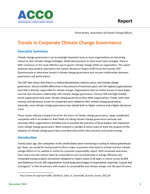 |
|
Climate change governance is an increasingly important issue as
more organizations are becoming mature in their climate change
strategies. While best practices in some areas have emerged,
there is little consensus on the most effective way to govern
climate change within an organization. This report examines data
publicly reported to the Carbon Disclosure Project (CDP) from
the Investor CDP Questionnaire to determine trends in climate
change governance and uncover relationships between governance
and performance. The CDP data shows that there is a
relationship between industry sector and climate change
governance. Sectors exhibit differences in the amount of
incentives given and the highest organizational level that is
directly responsible for climate change. Organizations that are
better known or have larger revenue also showed a relationship
with climate change governance. Fortune 500 and high visibility
brand organizations had more climate change governance than
other organizations. Finally, both total revenue and disclosure
scores for companies were related to their climate change
governance. Generally, more climate change governance was
related both to higher revenue and a higher disclosure score.
White Paper: Change Management and Climate Change in
Organizations
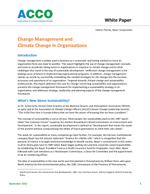 |
|
Change management is widely used in business as a systematic and
lasting method to move an organization from one state to
another. This report highlights the use of change management
concepts and tools to accelerate taking action in organizations
in response to climate change and to other challenges that stand
in the way of sustainable development. Ineffective change
management is the leading cause of failure in implementing
organizational programs. In addition, change management speeds
up results by successfully embedding the needed strategies for
the change into the business processes and operations of an
organization. Targeted towards climate change and sustainability
professionals, this report addresses the case for change
concerning sustainability and organizations; presents the change
management framework for implementing a sustainability strategy
in an organization; and addresses strategy, leadership and
planning aspects of the change management framework.
Microsoft’s Carbon Neutrality Commitment and Internal Carbon Fee
In May 2012, Microsoft announced a companywide commitment to
become carbon neutral beginning with its fiscal year 2013 (which
started July 1, 2012). The commitment—to achieve net-zero carbon
emissions for Microsoft’s data centers, software development
labs, offices, and employee air travel—is accompanied by an
internal carbon fee charged to business groups as an
accountability and carbon reduction fundraising measure. From
interviews with TJ DiCaprio, Microsoft’s Senior Director of
Environmental Sustainability, and using information from the
Microsoft whitepaper titled “Becoming Carbon Neutral,” the
Association of Climate Change Officers (ACCO) has assembled a
case study looking at some of the strategies and best practices
used to build Microsoft’s commitment.
Synthesis Report:
2012 Defense, National Security and Climate Change Workshop
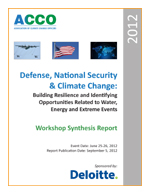 |
|
Since 1900, the global population has increased over fourfold,
putting unprecedented strain on our planet’s resources and life
supporting systems. Humanity’s contribution of greenhouse gases
(GHGs) to the atmosphere has begun to cause Earth’s climate to
change, warming hundreds of times faster than it has at any
point so far in our planet’s history. Awareness of climate
change is growing in the defense community, exemplified by the
2010 Quadrennial Defense Review (QDR), which was the first
version of the guiding defense document to explicitly consider
how climate change might affect the defense mission. On
June 25-26, 2012, over 130 leaders working in the climate and
defense nexus gathered in Washington, DC to participate in a
workshop titled “Defense, National Security and Climate Change:
Building Resilience and Identifying Opportunities Related to
Water, Energy and Extreme Events.” During those two days,
participants shared insights in roundtable sessions and listened
to leaders representing a broad range of organizations and
perspectives. The workshop aimed to present a variety of
perspectives from the defense and associated communities on the
national security and defense implications of climate change. By
bringing together the leading minds in the field, the workshop
sparked important conversations and allowed participants to
learn and share insights on the state of climate change work in
the defense community. The purpose of this report is to
distill some of the main themes and ideas derived from the
workshop and synthesize what was learned.
Click here to download
the full report.
Report Abstract:
Barriers to Implementing Climate Adaptation Plans: A Survey of
Climate Professionals Across Sectors
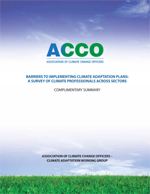 |
|
As organizations and entities across sectors implement climate
adaptation plans and policies, leaders are increasingly in need
of high-quality information to make better decisions. To find
this information, it is common practice for managers to look to
their peers for lessons learned and best management practices.
This approach works well of r seasoned constituencies who share
time-tested experiences, which, it should be mentioned, are
often standardized and accredited. However, through rapidly
rising popularity, managing the impacts of climate change is
still in its infancy, Field tested lessons have yet to
crystallize and best practices have a long way to go before they
are standardized. The result is that managers are left to
implement ad hoc climate plans with little to no feedback for
effectiveness in creating resilience or reducing actual risk. To
help resolve this issue, we took a hard look at the process of
planning for climate impacts across sectors. We discovered that
instead of looking for a quick fix, managers are faced with many
obstacles—some expected; other surprising—as they implement
their plans. This complimentary summary presents some highlights
and the full report is available for purchase.
Click here to download.
Report Abstract:
Climate Change Leadership in Higher Education Institutions
Over the last decade, climate change has become a critical topic
of concern. As a result, organizations across sectors, including
higher education institutions, are responding by making
significant organizational changes. Through a comprehensive
survey and in-depth interviews of individual institutions, we
analyzed how higher education institutions in the U.S. and
Canada are restructuring their governance structures in order to
respond to climate change. The 146-page final report contains
the results shown in dozens of tables, nearly 100 charts and
graphs, interviews, sources, and institutional profiles. This
complimentary summary presents some highlights and the full
report is available for purchase.
Click here to download.
|
